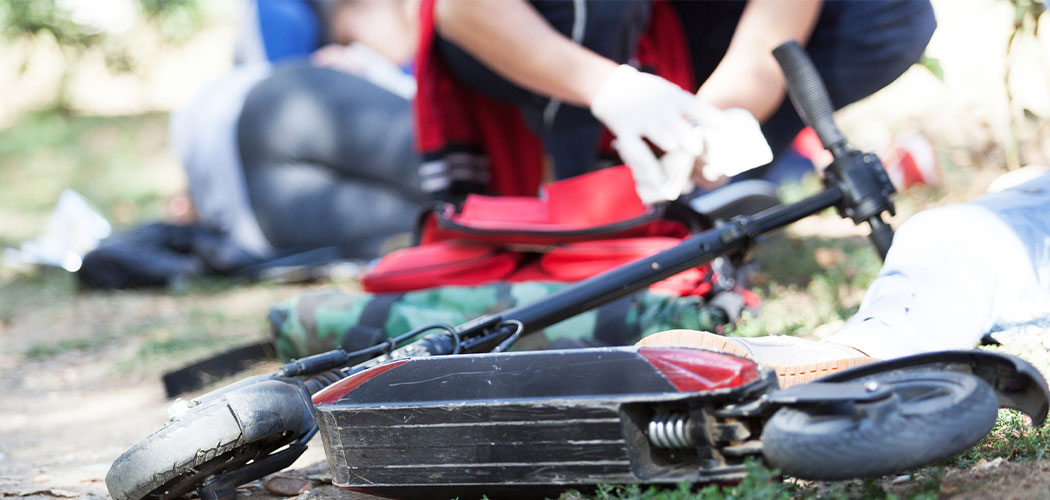Queensland’s paediatric trauma service team is urging caution with electric scooters this holiday season following a spike in serious injuries and fatalities this year.
An e-scooter city-hire scheme was introduced in Brisbane in November 2018. At Queensland Children’s Hospital, between 2019- 2023, 40 children were admitted following an e-scooter incident, with this rising to 11 patients admitted in the first six months of 2024 alone.
The Queensland Children’s Hospital trauma team is urging parents to mitigate the risks with e-scooters for children, by either avoiding use altogether or by adhering to the rules including the wearing of helmets and reducing speed. The team has even developed a mnemonic to remind parents and others of the rules.
“E-scooters were designed for over sixteen-year-olds, predominantly as a means of personal transportation for adult commuters. They are mandated in Queensland to be used at a maximum speed of 25km/hr, with a solo rider wearing a protective helmet,” said Nurse Trauma Manager Tona Gillen.


E-scooter mnemonic:
E-Essential facts in Queensland, to promote safety, before using an e-scooter.
S-Speed of 25km max. designated paths/bikeways, otherwise 12 km on shared footpaths.
C- Children over 12 years with adult supervision (e-scooters are designed for over 16-year-olds).
O-Only one person per e-scooter, ride solo. No doubling. No passengers.
O-Obligated the e-scooter rider is obligated to avoid pedestrians and other path-users. Be a courteous rider, sound your bell respectfully, keep left, and ride with due care and attention.
T-Tracks use designated tracks for e-scooters, shared paths, dedicated bike paths, and on-road bike lanes.
E-EtOH ethanol/alcohol should be avoided, don’t drink and ride a scooter.
R-Rules adhere to the rules and wear a protective helmet. Avoid using or holding your mobile phone when riding a scooter. Tiffany started playing badminton with family and friends aged 7-8. A family friend was a coach, so they also did some training.
Reduce speed and wear helmets
The top three injuries children sustained following e-scooter accidents were head injuries, extremity fractures, and multi-trauma, followed by facial injuries, such as fractures and lacerations. One quarter of those admitted required intubation and ventilation in the paediatric intensive care unit.
The severity of injuries sustained appeared to correlate with riders travelling at high speed, doubling on a scooter and not wearing helmets.
Almost half of injuries involved speed, with 47.5% of riders with documented speeds of 30 km/hr or higher, and the highest recorded speed 65km/hr.
“Injuries were more severe for those not wearing a helmet and included an extended length of stay in hospital or in the rehabilitation unit following traumatic brain injury,” said Ms Gillen.
“Of the patients who were riding e-scooters, 28% were documented to be wearing an adequately secured helmet, but worryingly 72% were documented as not wearing a helmet.”
Helmets, when worn correctly, reduce the impact of blunt trauma to the head, slashing the risk of serious head injury.
“It is mandated that well-fitted helmets be worn when using an e-scooter. E-scooters have small wheels that can slip easily on uneven or wet terrain. In addition, the rider has a higher centre of gravity than a push bike, making the e-scooter less stable and more likely to topple over.”
Regulation and legislation
“Regulation and legislation measures vary internationally, with e-scooters classified as motor vehicles requiring a valid license and insurance in some European countries. This may be a consideration for other countries including Australia, as e-scooters gain popularity”, said Ms Gillen.
Bearing witness to e-scooter incidents, with resultant catastrophic head injuries and polytrauma, can take a heavy toll on healthcare workers, she said. “Recurrent exposure is a risk factor and given the increased number of e-scooter-related injuries, vicarious trauma is a real phenomenon.”
The statistics are based on paediatric trauma data collected by the Queensland Children’s Hospital, a level 1 paediatric Major Trauma Centre.








